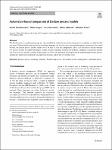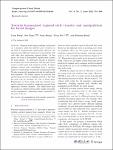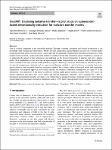Search
Author
- Jorgensen, Ed (3)
- McFadyen, Ron (3)
- Nora, El-Rashidy (3)
- Christian, Homeyer (2)
- next >
Subject
- programming (10)
- Open Access (8)
- Java (7)
- Programming (7)
- next >
Date issued
- 2020 - 2025 (293)
- 2010 - 2019 (39)
- 2000 - 2009 (2)
- 1999 - 1999 (1)
Has File(s)
- true (335)
Search Results
Our work exposes the structure of the template-based micro-kernels for ARM Neon (128-bit SIMD), ARM SVE (variable-length SIMD) and Intel AVX512 (512-bit SIMD), showing considerable performance for an NVIDIA Carmel processor (ARM Neon), a Fujitsu A64FX processor (ARM SVE) and on an AMD EPYC 7282 processor (256-bit SIMD). |
Wildfires affect countries worldwide as global warming increases the probability of their appearance. Monitoring vast areas of forests can be challenging due to the lack of resources and information. Additionally, early detection of wildfires can be beneficial for their mitigation. To this end, we explore in simulation the use of swarms of uncrewed aerial vehicles (UAVs) with long autonomy that can cover large areas the size of California to detect early stage wildfires. Four decentralised control algorithms are tested: (1) random walking, (2) dispersion, (3) pheromone avoidance and (4) dynamic space partition. |
The Declare process modeling language has been established within the research community for modeling so-called flexible processes. Declare follows the declarative modeling paradigm and therefore guarantees flexible process execution. For several reasons, declarative process models turned out to be hard to read and comprehend. Thus, it is also hard to decide whether two process models are equal with respect to their semantic meaning, whether one model is completely contained in another one or how far two models overlap. In this paper, we follow an automaton-based approach by transforming Declare process models into finite state automatons and applying automata theory for solving this issue. |
Innovation management is becoming more and more important for companies and especially the early stage of the innovation process, which has some problems due the volatile environment. The following design research contribution tries to take up these problems and to solve them with the situational theoretical approach. For this purpose, a new method, which is based on design thinking, was systematically and scientifically constructed through the playful aspect of gamification. In a single case study from the automotive industry, the new method could be applied in the field through three different runs and evaluated with the participants. |
Regional facial image synthesis conditioned on a semantic mask has achieved great attention in the field of computational visual media. However, the appearances of different regions may be inconsistent with each other after performing regional editing. In this paper, we focus on harmonized regional style transfer for facial images. A multi-scale encoder is proposed for accurate style code extraction. The key part of our work is a multi-region style attention module. It adapts multiple regional style embeddings from a reference image to a target image, to generate a harmonious result. |
Many modern applications, both scientific and commercial, are deployed to cloud environments and often employ multiple types of resources. That allows them to efficiently allocate only the resources which are actually needed to achieve their goals. However, in many workloads the actual usage of the infrastructure varies over time, which results in over-provisioning and unnecessarily high costs. In such cases, automatic resource scaling can provide significant cost savings by provisioning only the amount of resources which are necessary to support the current workload. Unfortunately, due to the complex nature of distributed systems, automatic scaling remains a challenge. |
This engaging volume celebrates the life and work of Theodor Holm "Ted" Nelson, a pioneer and legendary figure from the history of early computing. Presenting contributions from world-renowned computer scientists and figures from the media industry, the book delves into hypertext, the docuverse, Xanadu, and other products of Ted Nelson's unique mind. Topics and features: Includes a cartoon and a sequence of poems created in Nelson's honor, reflecting his wide-ranging and interdisciplinary intellect Presents peer histories, providing a sense of the milieu that resulted from Nelson's ideas Contains personal accounts revealing what it is like to collaborate directly with Nelson Describes Nelson's legacy from the perspective of his contemporaries from the computing world and the scholar... |
Compressive sensing (CS) is a mathematically elegant tool for reducing the sensor sampling rate, potentially bringing context-awareness to a wider range of devices. Nevertheless, practical issues with the sampling and reconstruction algorithms prevent further proliferation of CS in real world domains, especially among heterogeneous ubiquitous devices. Deep learning (DL) naturally complements CS for adapting the sampling matrix, reconstructing the signal, and learning from the compressed samples. While the CS–DL integration has received substantial research interest recently, it has not yet been thoroughly surveyed, nor has any light been shed on practical issues towards bringing the CS–DL to real world implementations in the ubiquitous computing domain. |
Dust is a major component of the interstellar medium. Through scattering, absorption and thermal re-emission, it can profoundly alter astrophysical observations. Models for dust composition and distribution are necessary to better understand and curb their impact on observations. A new approach for serial and computationally inexpensive production of such models is here presented. Traditionally these models are studied with the help of radiative transfer modelling, a critical tool to understand the impact of dust attenuation and reddening on the observed properties of galaxies and active galactic nuclei. |
We present an extension to the federated ensemble regression using classification algorithm, an ensemble learning algorithm for regression problems which leverages the distribution of the samples in a learning set to achieve improved performance. We evaluated the extension using four classifiers and four regressors, two discretizers, and 119 responses from a wide variety of datasets in different domains. |










